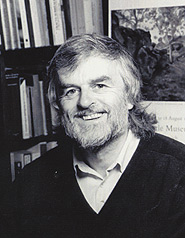Berkeleyan
Prestigious Mellon grant awarded to art history's Timothy Clark
Proceeds will allow him to continue his research, bring international conferences to campus, and attract top grad students
![]()
| 08 February 2006
Timothy Clark, a professor of art history and a leading authority on modern art, is one of four scholars of the humanities to receive an Andrew W. Mellon Foundation distinguished achievement award. The Mellon grant, worth up to $1.5 million, is designed to support individual scholarly research, while at the same time expanding study and teaching at the recipients' home institutions over a period of two to three years.
 Timothy Clark |
In its announcement, the foundation lauded Clark as an outstanding teacher and mentor whose students have become leaders in art history: "His works merge the history of art with social history, while at the same time providing astonishingly original and profoundly researched readings of major figures in art and criticism, including Courbet, Manet, and Picasso."
Clark, the George C. and Helen N. Pardee Chair and Professor of Modern Art, calls the Mellon award "an extraordinary and daunting honor." It has prompted him, he says, to review his basic interests as an art historian, offering him an opportunity to explore them over the next three years in ways that will contribute to Berkeley's intellectual life.
"We are living in a time of war, and part of that war, it is widely agreed, is a struggle for mastery in the realm of images," Clark says. "At such a moment it is appropriate, I think, to struggle with the question of what visual representations are - how they differ from verbal communications, how they persuade us (or fail to persuade us) of their truth, whether they are capable of real complexity in the face of events."
A native of Bristol, England, Clark is well-known for his analysis of Impressionism in The Painting of Modern Life: Paris in the Art of Manet and his Followers (1985) as well as in Image of the People: Gustave Courbet and the 1848 Revolution (1973) and The Absolute Bourgeois: Artists and Politics in France, 1848-1851 (1973).
Clark's most recent works include Farewell to an Idea: Episodes From a History of Modernism (1999) and Afflicted Powers: Capital and Spectacle in a New Age of War (2005), a book jointly written with geography professor Michael Watts and two independent Bay Area writers, Iain Boal and Joseph Matthews. Clark is completing work on a new book due out this summer, The Sight of Death: An Experiment in Art Writing. It centers on two landscape paintings by the 17th-century French painter Nicolas Poussin.
Clark says he plans to press on with his research into the life of Poussin, but will also pursue a longstanding interest in the art of Pablo Picasso - "who still looms uncomfortably over the visual culture of the past century," he says, "in ways we have barely begun to account for."
A book on Picasso also is in the works for Clark, who plans to make the artist the focus of his Mellon Lectures at the National Gallery of Art in Washington, D.C., probably at the end of the award period. The book will look at Picasso with the aid of certain concepts borrowed from the German philosopher Friedrich Nietzsche.
The Mellon grant will enable Clark to reduce his teaching load over the next two years and spend more time on his research. He says he is looking forward to relocating to Rome in the third year of the award to wrap up his Poussin research and to concentrate on writing the Picasso lectures.
In addition, Clark is starting to plan a series of international conferences at Berkeley. The first will be devoted to a series of key paintings done by Picasso in the late 1920s, where Picasso dwells on the strange mechanics of the studio situation - in particular, the charged and ambivalent relation between artist and model.
Another will revolve around Roman sarcophagi. "This topic is just crying out for a symposium," Clark explained. "We are at one of those moments when a seemingly familiar set of objects is being looked at afresh by scholars across the globe."
Yet another forum of art historians, archaeologists, and others will explore the impressive body of mostly small-scale sculptures and figurines from the Neolithic Age that has been excavated over the past 25 years. Clark's Berkeley colleagues Christopher Hallet, an associate professor and an expert on Roman art, and Whitney Davis, a professor of history and an authority on the theory of ancient and modern art, will help organize the second and third conferences.
In addition, says Clark, part of the Mellon grant each year will be devoted to improving the art-history department's level of graduate funding.
"This is a crucial issue for me and my colleagues, at a time when we are competing for the very best students with immensely rich private universities," he says. "And the award means that I shall be able to bring certain scholars to campus to teach courses in the art-history department, and to fund a two-year postdoctoral fellowship. All of this, I hope, will make a difference to the humanities in the university at large."

